
Royal Botanic Gardens, Kew is a non-departmental public body in the United Kingdom sponsored by the Department for Environment, Food and Rural Affairs. An internationally important botanical research and education institution, it employs 1,100 staff. Its board of trustees is chaired by Dame Amelia Fawcett.

Rye is a grass grown extensively as a grain, a cover crop and a forage crop. It is grown principally in an area from Eastern and Northern Europe into Russia. It is much more tolerant of cold weather and poor soil than other cereals, making it useful in those regions; its vigorous growth suppresses weeds and provides abundant forage for animals early in the year. It is a member of the wheat tribe (Triticeae) which includes the cereals wheat and barley. Rye grain is used for bread, beer, rye whiskey, and animal fodder. In Scandinavia, rye was a staple food in the Middle Ages, and rye crispbread remains a popular food in the region. Europe produces around half of the world's rye; relatively little is traded between countries. A wheat-rye hybrid, triticale, combines the qualities of the two parent crops and is produced in large quantities worldwide. In European folklore, the Roggenwolf is a carnivorous corn demon or Feldgeist.

Secale is a genus of the grass tribe Triticeae, which is related to barley (Hordeum) and wheat (Triticum). The genus includes cultivated species such as rye as well as weedy and wild rye species. The best-known species of the genus is the cultivated rye, S. cereale, which is grown as a grain and forage crop. Wild and weedy rye species help provide a huge gene pool that can be used for improvement of the cultivated rye.
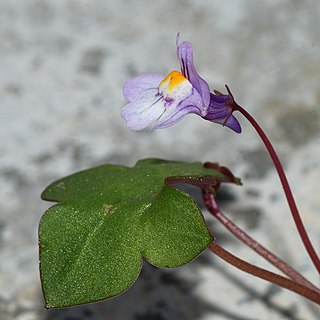
Cymbalaria is a genus of about 10 species of herbaceous perennial plants previously placed in the family Scrophulariaceae, but recently shown by genetic research to be in the much enlarged family Plantaginaceae.
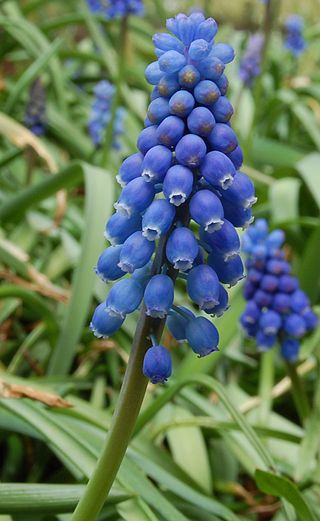
Muscari is a genus of perennial bulbous plants native to Eurasia that produce spikes of dense, most commonly blue, urn-shaped flowers resembling bunches of grapes in the spring. The common name for the genus is grape hyacinth, but they should not be confused with hyacinths. A number of species of Muscari are used as ornamental garden plants.
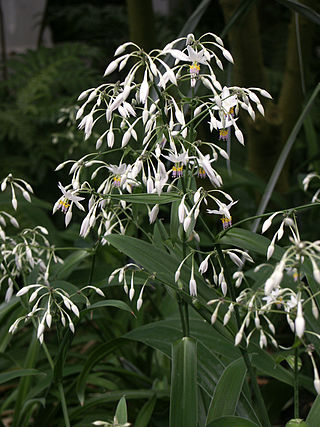
Arthropodium is a genus of herbaceous perennial plants in the subfamily Lomandroideae of the family Asparagaceae. Members of this genus are native to Australia, New Zealand, New Caledonia, and Madagascar.

Dichopogon strictus, commonly known as chocolate lily, is a herbaceous perennial plant species native to Australia.

Lamium galeobdolon, the yellow archangel, is a species of flowering plant in the mint family Lamiaceae. It is native to Europe and western Asia but it is widely introduced in North America and elsewhere. It is the only species in the genus Lamium with yellow flowers. Another common name for this species is golden dead-nettle. In New Zealand, it is called the aluminium plant or artillery plant. The common names archangel and dead-nettle have been in use for hundreds of years, dating back to at least the 16th century.
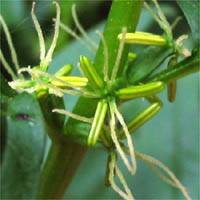
Datisca glomerata is a species of plant native to California, Nevada, and Baja California known by the common name Durango root. It is one of only two to four species in the plant family Datiscaceae. It is an erect perennial herb with distinctive long, pointed, often sharply serrated leaves. It is said to superficially resemble Cannabis species. Its yellowish green flowers grow in clusters from the axilla of the leaf, where it joins the stem. A thick stand of the plant can form a medium-sized bush. All parts of this plant are toxic and in some areas, it is considered a noxious weed. It is reported to be poisonous to cattle.

Eleocharis quinqueflora is a species of spikesedge known by the common names fewflower spikerush and few-flowered spike-rush. It is widespread across Europe, North Africa, northern Asia, and North America. There are also isolated populations in Argentina and Chile.

Calamagrostis arundinacea is a species of bunch grass in the family Poaceae, native to Eurasia, China and India. Under its synonym Calamagrostis brachytricha it has gained the Royal Horticultural Society's Award of Garden Merit.
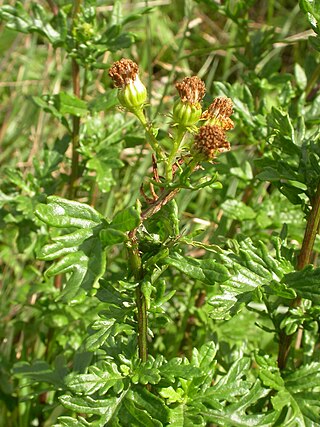
Jacobaea erucifolia, the hoary ragwort is a species of flowering plant in the genus Jacobaea and the family Asteraceae. It is a perennial or rhizomatous geophyte native to temperate Eurasia, ranging from Europe to Siberia, Turkey, Iran, Central Asia, Mongolia, China, and Japan.

Dichopogon is a genus of perennial herbs, native to Australia and New Guinea. It is included in the genus Arthropodium by some authorities, although recognized as a distinct genus by others. In the APG III classification system, it is placed in the family Asparagaceae, subfamily Lomandroideae.

Lumnitzera is an Indo-West Pacific mangrove genus in the family Combretaceae. An English common name is black mangrove. Lumnitzera, named after the German botanist, Stephan Lumnitzer (1750-1806), occurs in mangroves from East Africa to the Western Pacific, and northern Australia.

Adiantum raddianum, the Delta maidenhair fern, is one of the most popular ferns to grow indoors. It is native to South America and its common name comes from its shiny, dark leafstalks that resemble human hair. It typically grows about 17–19 in (43–48 cm) tall and up to 22 in (56 cm) wide. In the wild, it is found on forest floors, rock crevices, river banks, coastal cliffs, and basalt banks along trails and streams. The triangular fronds are semi-erect in the beginning then droop gracefully as they age and can be up to 12 inches (30 cm) long by 6 inches (15 cm) wide. The genus name Adiantum comes from the Greek word "adiantos", meaning "unwetted".
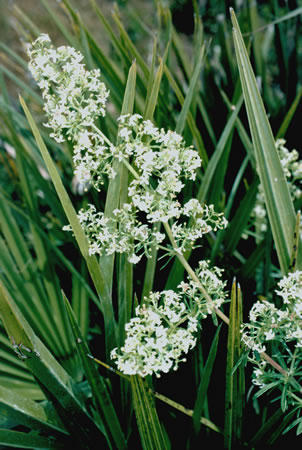
Galium litorale is a rare species of bedstraw in the Rubiaceae family. It is endemic to the island of Sicily in the Mediterranean Sea. In Italian it is known as caglio costiero.
Allium stamineum is a species of flowering plant in the Amaryllidaceae family. It is an onion found in the Middle East.
Allium cupaniRaf. is a species of wild onion from the central and eastern Mediterranean region.
Bromus intermedius, the intermediate brome, is a species of flowering plant in the family Poaceae. It is native to the Mediterranean countries and islands, and eastwards to Afghanistan. It can be found growing on serpentine soils.
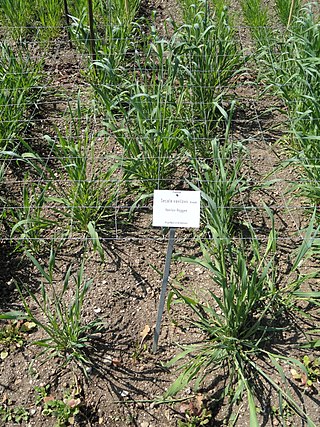
Secale vavilovii is a species of grass, native to Turkey, the Transcaucasus, Iraq, and Iran. An annual, it is a crop wild relative of rye and is being studied for its resistance to Fusarium ear blight and Septoria leaf blotch.
















